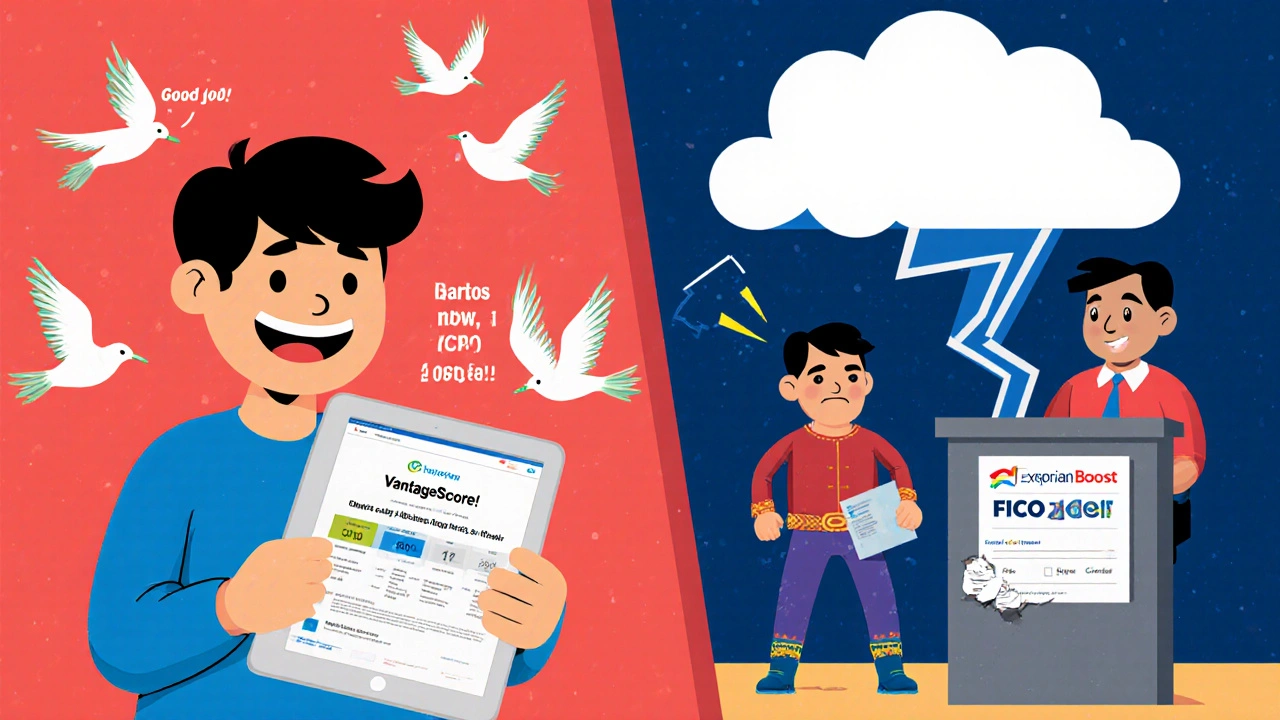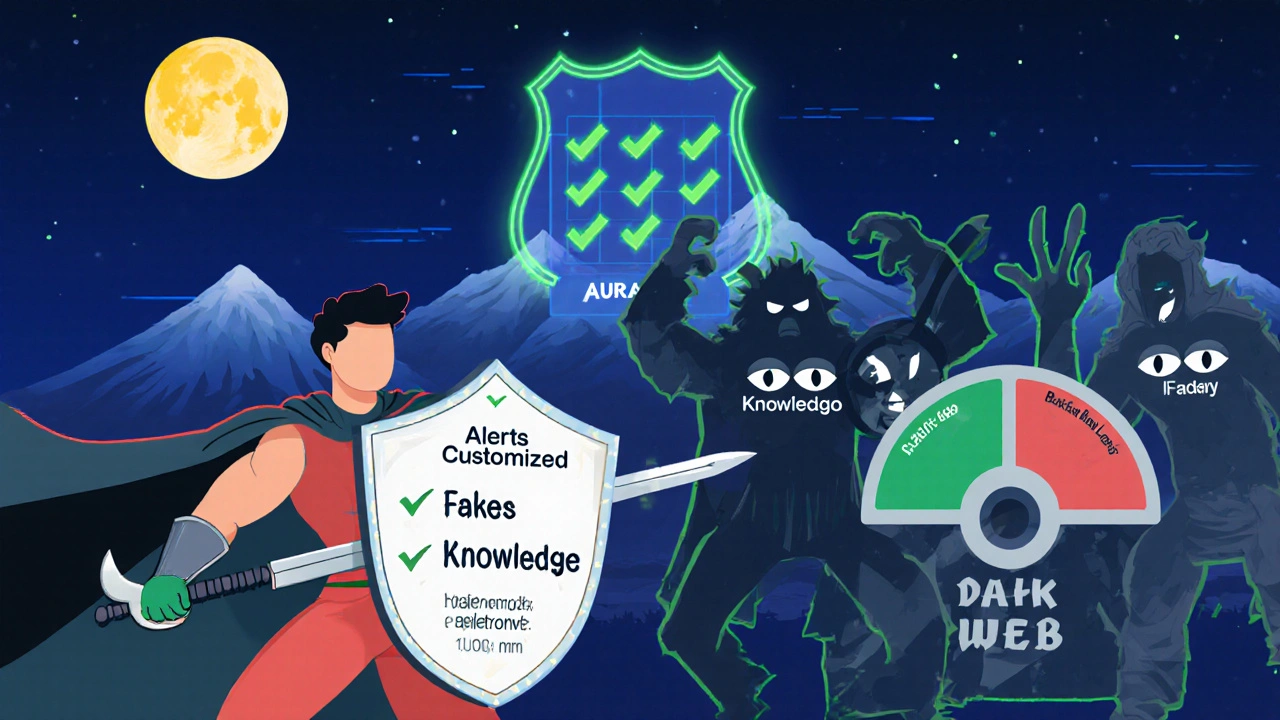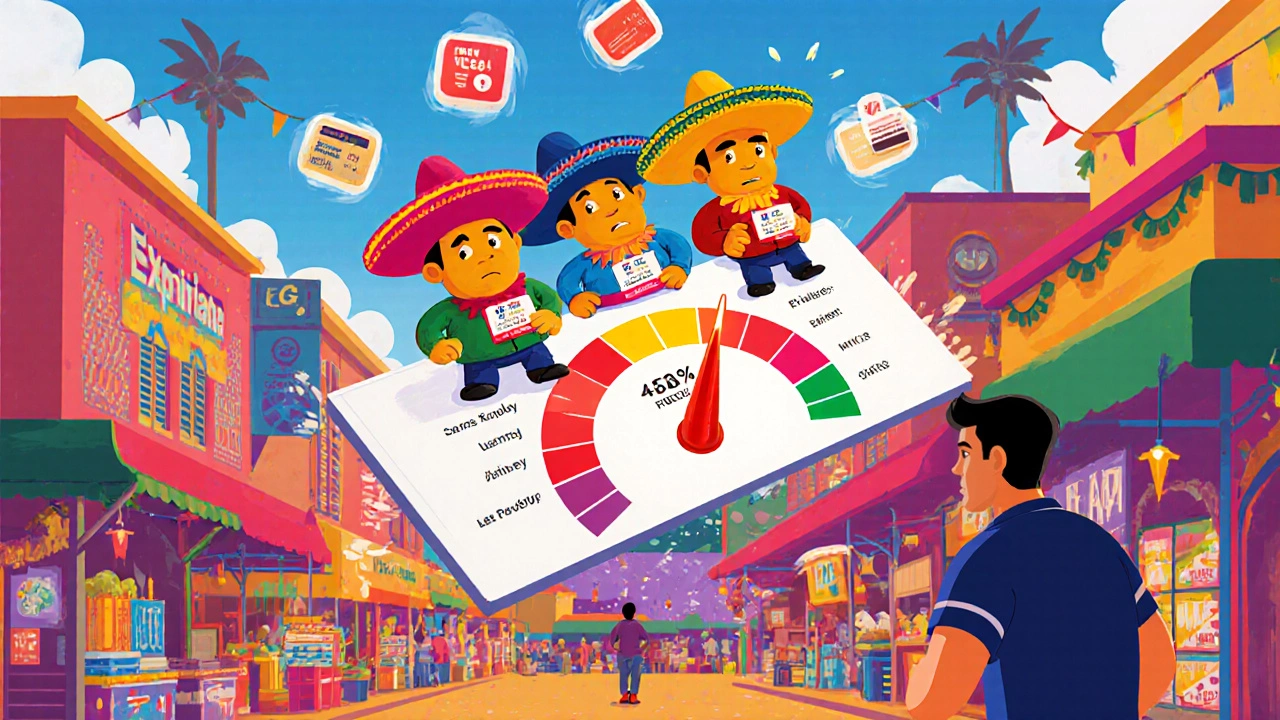Credit Score Simulator
How Your Credit Score Works
Your credit score is determined by five key factors: payment history (35%), credit utilization (30%), credit age (15%), credit mix (10%), and new credit inquiries (10%). See how changes to each factor affect your score below.
Important: This is a simplified simulation based on FICO scoring models. Actual scores may vary based on credit bureau data and other factors.
Current Credit Factors
Additional Factors
Estimated Credit Score
Score Impact Breakdown
Key Takeaway: Your credit score isn't a single number—it's a dynamic calculation based on your financial behavior. The best monitoring apps show you exactly how each change affects your score in real-time, helping you make informed decisions.
Knowing your credit score isn’t enough. You need to know why it changed, when it changed, and what you can actually do about it. That’s where credit score monitoring apps come in - not as fancy dashboards, but as real-time early warning systems for your financial health.
What These Apps Actually Do (And What They Don’t)
Credit score monitoring apps don’t create your score. They pull data from Experian, Equifax, or TransUnion - the three credit bureaus that track your borrowing history. Then they show you your score, flag changes, and break down what’s driving those changes. But not all apps do this the same way. Some give you a score that lenders never see. Others show you the exact FICO score used by 90% of banks and credit card companies. That’s the difference between guessing and knowing. If you’re using a free app like Credit Karma, you’re likely seeing a VantageScore. It’s useful for spotting big red flags - like a new loan you didn’t apply for - but it’s not the number a lender pulls when you apply for a mortgage. FICO scores are what matter most. If you’re trying to qualify for a car loan or refinance your home, you need to know what FICO says, not what VantageScore says.Five Key Factors That Move Your Credit Score
Your score doesn’t change randomly. It moves because of five clear, measurable things in your financial behavior. Monitoring apps break these down so you don’t have to guess.- Payment history (35%) - One missed payment can drop your score by 100 points. Apps alert you when a bill is late, even if it hasn’t hit your credit report yet.
- Credit utilization (30%) - This is how much of your available credit you’re using. If you max out your credit card, your score drops. Good apps show you your utilization ratio daily and suggest spending limits to stay under 30%.
- Credit age (15%) - The longer your accounts have been open, the better. Closing an old card can hurt you. Apps warn you if you’re about to close a long-standing account.
- Credit mix (10%) - Having different types of credit (credit cards, auto loans, mortgages) helps. But you don’t need to take on debt just to improve this. Apps note if you’re missing a type of credit and suggest safe ways to build it.
- New credit inquiries (10%) - Every time you apply for credit, a hard inquiry shows up. Too many in a short time signals risk. Apps alert you to new inquiries and let you know if they’re from you or someone else.
Free vs. Paid: What You’re Really Getting
Free apps like Credit Karma and NerdWallet are great starters. They give you access to your score, basic alerts, and sometimes even free credit reports. But here’s the catch: they monitor only two bureaus (usually TransUnion and Equifax), and they use VantageScore. Experian’s free app only monitors its own data. That means if a problem shows up on Equifax but not Experian, you won’t know. And if you’re applying for a loan that pulls Equifax, you’re flying blind. Paid services fix this. MyFICO, Experian Premium, and Aura all monitor all three bureaus. They give you FICO scores - the real ones. MyFICO’s Advanced plan costs $29.95/month and gives you FICO Score 8 and 9 updates from all three bureaus, daily score tracking, and a simulator that shows you how paying off a debt or opening a new card will impact your score before you do it. Aura, at $12/month, is the most affordable full-service option. It includes credit monitoring from all three bureaus, dark web scanning, password management, and even financial account monitoring. If you’re worried about identity theft, it’s a solid bundle. Experian’s Premium plan at $24.99/month adds something unique: Experian Boost. It lets you add on-time utility and phone bill payments to your credit file. That’s huge if you’ve never had credit cards but pay your bills on time. People using Boost see an average score increase of 13 points - sometimes more.
Alerts That Matter (And the Ones That Don’t)
Not every alert is useful. Some apps flood you with noise. A good alert tells you:- A new account was opened in your name
- Your credit utilization jumped above 50%
- A payment you thought was paid is now 30 days late
- A hard inquiry happened without your approval
How to Choose the Right App for You
Ask yourself three questions:- Are you building credit or fixing damage? If you’re rebuilding after bankruptcy or a missed payment, you need FICO scores and detailed explanations. Go with MyFICO or Experian Premium.
- Are you worried about identity theft? If you’ve been a victim before or live in a high-fraud area, get Aura or PrivacyGuard. They scan the dark web for your Social Security number, bank accounts, and even medical records.
- Do you want to be told what to buy? Credit Karma and NerdWallet push credit cards and loans. They earn money when you sign up. That’s not always bad - but it’s a conflict. If you want unbiased advice, go with MyFICO or Experian. They don’t sell you products.

The Hidden Risk: Data Privacy
These apps have your name, address, Social Security number, bank accounts, and spending habits. That’s a goldmine for hackers. In September 2024, a major monitoring service suffered a breach exposing 1.2 million users’ data. The Consumer Financial Protection Bureau responded with new rules in early 2025, requiring apps to use AES-256 encryption and clearly state how they use your data. Look for apps that:- Use end-to-end encryption
- Don’t sell your data to third parties
- Let you delete your account and all data permanently
What Experts Say
John Ulzheimer, former FICO executive, says: “If you’re not seeing a FICO score, you’re not seeing what lenders see.” Beverly Harzog, consumer finance analyst, adds: “Experian’s free service is good for a baseline. But if you’re serious about your credit, pay for the FICO score. It’s the only score that tells you where you really stand.” The data backs them up. A 2024 Edvisors study found that users who monitored their FICO scores consistently improved their credit by an average of 47 points in six months. Those using only VantageScore saw only a 12-point gain.Final Tip: Don’t Just Watch - Act
Monitoring apps aren’t magic. They don’t fix your credit. You do. If your score drops because you maxed out a card, pay it down. If a new account shows up you didn’t open, freeze your credit. If you’re being hit with hard inquiries, stop applying for credit for six months. The best apps give you the power to act. Use that power. Check your score weekly. Set up alerts for utilization over 30%. Review your credit report every three months. That’s how you build real, lasting credit health.Do credit monitoring apps hurt your credit score?
No. Checking your own credit score through a monitoring app is a soft inquiry. It doesn’t affect your score. Only when lenders check your credit (hard inquiries) can it drop slightly. Monitoring apps only show you your score - they don’t request it from bureaus in a way that counts as a loan application.
Why is my score different on Credit Karma vs. Experian?
Because they use different scoring models. Credit Karma shows VantageScore 3.0 from TransUnion and Equifax. Experian shows FICO Score 8 from its own data. Lenders use FICO, so Experian’s number is more accurate for loan approvals. Also, not all bureaus have the same information - one might have a late payment the others don’t.
Can I trust free credit monitoring apps?
Yes - if you understand their limits. Free apps like Credit Karma and NerdWallet are safe and useful for tracking general trends. But they don’t show FICO scores or monitor all three bureaus. They also make money by recommending financial products. If you’re just checking your score occasionally, they’re fine. If you’re applying for a mortgage or car loan, pay for a FICO-based service.
How often should I check my credit score?
Check it weekly if you’re actively working on improving it. If your credit is stable, once a month is enough. The goal isn’t to obsess over small changes - it’s to catch fraud or big drops early. Most apps let you set up daily alerts for major changes, so you don’t have to check manually.
What’s the fastest way to raise my credit score?
Pay down your credit card balances. Credit utilization is the second biggest factor in your score. Dropping from 80% to 20% can boost your score by 50+ points in 30 days. Also, make sure all your payments are on time - even one late payment can undo months of progress. If you have utility bills, sign up for Experian Boost to add them to your report.
Do I need to pay for credit monitoring?
Not if you’re just curious. But if you’re planning to buy a house, car, or apply for a credit card soon, yes. Free services miss critical data. FICO scores from all three bureaus, identity theft protection, and fraud alerts are worth $10-$30 a month. For most people, the cost is far less than the interest you’d pay on a loan because your score was low.

Astha Mishra
October 30, 2025 AT 18:01It's fascinating how deeply intertwined credit is with our sense of self-worth in modern society. We treat a three-digit number as a moral ledger, when in truth it's just a statistical artifact of financial systems designed by people who never had to choose between rent and groceries. The real innovation isn't in the apps-they’re just mirrors-but in our collective willingness to obsess over them. I’ve watched friends spiral into anxiety over a 12-point dip, unaware that their score was never meant to be a scorecard of character. Maybe what we need isn’t better monitoring, but better meaning. What if we stopped seeing credit as a judgment and started seeing it as a tool? A hammer doesn’t judge the carpenter; it just helps build. The same should be true here.
And yet... I still check mine every morning. Human nature, I suppose.
Kenny McMiller
November 1, 2025 AT 05:19Bro, FICO 8 is the OG. VantageScore is like using Android metrics to judge an iPhone’s performance. You’re not wrong to care, but you’re definitely using the wrong ruler. MyFICO’s simulator is the only thing that actually lets you simulate the domino effect of paying off that $2k card before applying for a lease. I used it last year-dropped my utilization from 78% to 22% in 17 days, scored a 4.9% auto loan. Experian Boost? Absolute cheat code if you’ve got utility bills. I added my $85/month internet and got +18 points overnight. No debt. No credit card. Just paying for wifi and suddenly I’m ‘creditworthy.’ Wild.
Also, Aura? Overkill unless you’re a celeb or a data broker’s ex. Free Experian + AnnualCreditReport.com = 90% of what you need. Stop overpaying for dashboards.
Dave McPherson
November 1, 2025 AT 17:55Let’s be real-most people who use Credit Karma are just scrolling through ‘Get Pre-Approved for $10K!’ ads while eating cold pizza at 2 a.m. and wondering why their score dropped. These apps aren’t tools-they’re dopamine machines disguised as financial advisors. The fact that you’re even considering paying $12/month to know if someone opened a credit card in your name? That’s not vigilance. That’s trauma. You’ve been burned. I get it. But now you’re just feeding the machine.
And don’t get me started on ‘Experian Boost.’ Adding your Netflix payments? That’s not building credit, that’s performing financial cosplay. You’re not a credit hero-you’re a guy who finally figured out how to game a system that was never designed for you in the first place. Congrats. You’re now in the top 47% of people who don’t default on their cable bill. High five.
Meanwhile, the real problem? Banks still use FICO 8 like it’s 2009. They’re not even using FICO 9. The whole industry is a relic wrapped in a SaaS subscription. Paying for monitoring is like buying a gold-plated flashlight to check if your house is on fire. You’re not fixing the wiring. You’re just buying a fancier way to see the smoke.
Julia Czinna
November 3, 2025 AT 06:49I appreciate how thorough this breakdown is. The distinction between VantageScore and FICO is something so many people miss-and it’s not just technical, it’s emotional. When you’re trying to rebuild after financial hardship, seeing your score move can feel like progress. But if the number you’re watching doesn’t reflect reality, that progress is an illusion.
I switched from Credit Karma to MyFICO after a loan denial last year. Turned out my VantageScore was 720, but my FICO was 648. I was devastated. Then I realized: I’d been optimizing for the wrong target. I paid down my cards, kept my utilization under 10%, and waited. Six months later, I got approved for a car loan at 4.1%. No magic. Just patience and the right data.
Also, the privacy note is critical. I’ve seen too many ‘free’ apps that ask for bank logins under the guise of ‘account linking.’ If they can see your balance, they can guess your spending. That’s not monitoring-that’s surveillance. I only use services that don’t require login credentials. If they can’t access your account, they can’t sell your habits. Simple.
And yes-checking weekly is enough. Obsessing over a 3-point change is like checking the weather every 10 minutes because you’re planning a picnic. You’ll drive yourself crazy. Set the alert for >30% utilization or new inquiries, and live your life.
RAHUL KUSHWAHA
November 4, 2025 AT 17:08Thanks for this. I just started using Experian Free and it helped me notice a late payment I didn’t even know about. Fixed it in 2 days. :)
Still nervous about paying for anything though... but maybe next year.